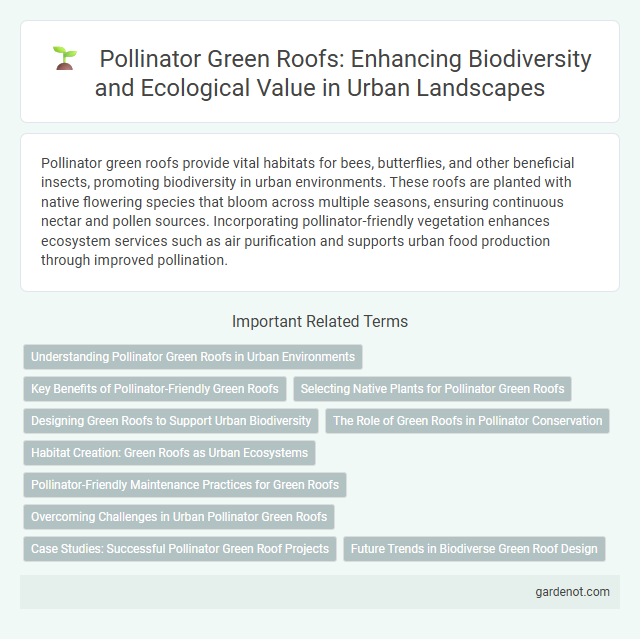Pollinator green roofs provide vital habitats for bees, butterflies, and other beneficial insects, promoting biodiversity in urban environments. These roofs are planted with native flowering species that bloom across multiple seasons, ensuring continuous nectar and pollen sources. Incorporating pollinator-friendly vegetation enhances ecosystem services such as air purification and supports urban food production through improved pollination.
Understanding Pollinator Green Roofs in Urban Environments
Pollinator green roofs create essential habitats for bees, butterflies, and other pollinators within urban environments, enhancing biodiversity and supporting local ecosystems. These roofs typically feature native flowering plants that provide nectar and pollen resources, fostering pollinator health and promoting urban ecological resilience. Integrating pollinator-friendly vegetation on green roofs helps mitigate the loss of natural habitats caused by urbanization and contributes to improved pollination services for nearby green spaces.
Key Benefits of Pollinator-Friendly Green Roofs
Pollinator-friendly green roofs provide essential habitats for bees, butterflies, and other pollinators, contributing to increased biodiversity in urban environments. These green roofs improve air quality, reduce urban heat island effects, and enhance stormwater management. By supporting pollinator populations, they promote the health of local ecosystems and contribute to food security through improved pollination services.
Selecting Native Plants for Pollinator Green Roofs
Selecting native plants for pollinator green roofs enhances biodiversity by providing essential nectar and pollen resources tailored to local bee and butterfly species. Native flora such as Echinacea purpurea, Asclepias tuberosa, and Solidago canadensis supports pollinator health while adapting well to rooftop microclimates. Incorporating a diverse mix of flowering native plants with staggered bloom times ensures continuous food supply and habitat stability for pollinators throughout the growing season.
Designing Green Roofs to Support Urban Biodiversity
Pollinator green roofs are engineered to create habitats that support urban biodiversity by integrating native flowering plants and diverse vegetation layers tailored to local pollinator species. These designs enhance ecological connectivity within cityscapes, promoting sustainable pollination services crucial for urban flora and food production. Incorporating varied substrate depths and water retention systems optimizes habitat suitability for bees, butterflies, and other essential pollinators.
The Role of Green Roofs in Pollinator Conservation
Pollinator green roofs provide essential habitats that support biodiversity by offering native flowering plants critical for bees, butterflies, and other pollinators. By enhancing urban ecosystems, these green roofs help mitigate habitat loss caused by urbanization and contribute to the conservation of declining pollinator populations. Studies show that strategically designed pollinator green roofs increase local pollination services and promote ecological resilience in metropolitan areas.
Habitat Creation: Green Roofs as Urban Ecosystems
Pollinator green roofs serve as vital habitats for bees, butterflies, and other pollinators, enhancing urban biodiversity by supporting various native plant species. These ecosystems contribute to the survival of key pollinator populations amid city environments dominated by concrete and limited green spaces. Effective habitat creation on green roofs involves selecting diverse, nectar-rich plants that provide forage and nesting opportunities, promoting ecological resilience and pollination services in urban areas.
Pollinator-Friendly Maintenance Practices for Green Roofs
Pollinator-friendly maintenance practices for green roofs include minimizing pesticide use and selecting native flowering plants that provide abundant nectar and pollen throughout the growing season. Regular monitoring of plant health and promoting structural diversity through varying plant heights support diverse pollinator species. Incorporating seasonal pruning and careful irrigation preserves habitat quality and encourages pollinator visitation on green roofs.
Overcoming Challenges in Urban Pollinator Green Roofs
Urban pollinator green roofs face challenges such as limited floral diversity, harsh rooftop conditions, and habitat fragmentation that hinder pollinator population growth. Implementing native, drought-resistant plant species and creating microhabitats can enhance nectar availability and shelter for pollinators like bees and butterflies. Incorporating soil amendments and water retention systems improves plant resilience and supports sustainable pollinator ecosystems in urban environments.
Case Studies: Successful Pollinator Green Roof Projects
Case studies of pollinator green roof projects highlight their effectiveness in enhancing urban biodiversity and supporting local ecosystems. The Chicago City Hall green roof, featuring native wildflowers, demonstrated a significant increase in bee and butterfly populations within the urban core. Similarly, the Vancouver Convention Centre's pollinator roof project successfully integrated diverse flowering plants, creating a thriving habitat for pollinators while improving stormwater management.
Future Trends in Biodiverse Green Roof Design
Pollinator green roofs are increasingly integrating native plant species to enhance habitat connectivity for bees, butterflies, and other vital pollinators in urban environments. Advances in modular green roof technology enable customizable substrates and irrigation systems, optimizing conditions for diverse floral communities to thrive. Future trends emphasize smart monitoring tools that track pollinator activity and plant health, driving adaptive management strategies to maximize biodiversity and ecosystem services.
Pollinator green roof Infographic

 gardenot.com
gardenot.com